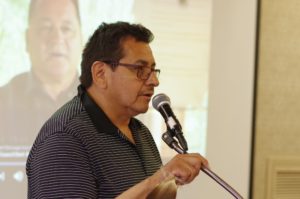Pic Mobert First Nation Ratifies Constitution: one step closer to AES vote

By Rick Garrick
PIC MOBERT FIRST NATION—Pic Mobert is looking towards the future after 75 of the 106 community members who cast a vote endorsed the Chi-Naaknigewin constitution on July 29-30, 2016.
“[We received] congratulations from some of the community members,” says Pic Mobert Councilor Louis Kwissiwa. “They are happy that the Constitution passed and now we can start developing our own laws.”
Pic Mobert Chief Wayne Sabourin says the Constitution will also help the community to set their own destination of where they want to go in the future.
“It helps us get away from [parts of] the Indian Act, where we always have to wait for the government to give us permission,” Sabourin says. “Now I believe we can make our own permission on moving forward.”
Pic Mobert can also exercise its jurisdiction under the Anishinabek Nation Education Agreement now that it has ratified its Constitution.
A minimum of 12 Anishinabek First Nations must ratify the Anishinabek Nation Education Agreement for it to be considered ratified. The Anishinabek Nation Education Agreement ratification vote will be held over a one-week period from November 28 to December 2, 2016. Other Anishinabek Nation communities that have ratified their constitutions include, but not limited to: Nipissing, Wikwemikong, Mississauga, Atikameksheng Anishnawbek, and Biigtigong Nishnaabeg.
“With this new Anishinabek Nation Education Agreement between Anishinabek Nation and the Federal Government, First Nations are able to create their own curriculum and have further core funding for our language,” Kwissiwa says. “With the Anishinabek Nation Education Agreement, we are not going to be taking away from the basics that are being taught in the schools. The goal of the Anishinabek Education System is the language and to have better funding for libraries, physical education, and getting out to the land.”
The Anishinabek Education System will feature First Nations control over education from Junior Kindergarten to Grade 12; it will be controlled completely by First Nations, respectively; it will allow First Nations to share resources for student success; and it will have secure and predictable funding from the Federal Government.
“It will be more dollars for education and that is what we really need,” Sabourin says. “Our teachers will have more resources. We can pay our teachers what we should pay them. If we can pay our teachers better, maybe it will encourage some students to go to school and become school teachers.”
Kwissiwa says the Chi-Naaknigewin Constitution ratification process is just the first step in the development of the community’s Constitution.
“It’s going to take time — change doesn’t happen overnight,” Kwissiwa says. “It’s going to take years to develop. It could take 10 years, 20 years for certain laws. There’s got to be lots of consultation back and forth between the band and legal representatives and the community until we find that right balance where everybody could agree on it and we are able to begin to implement it as a community.”
Pic Mobert began working on the Constitution process in April 2016, with constitutional workshop/information sessions held in the community on June 2 and 20, 2016. Mail-in Ballots were sent out to off-Reserve band members on June 20 and off-Reserve constitutional workshop/information sessions were held in Sault Ste. Marie on June 23, 2016, and in Thunder Bay on July 7, 2016.
An information booth was also held at the community’s powwow grounds on July 29 and 30, 2016, during the annual powwow.


